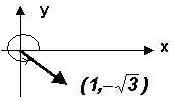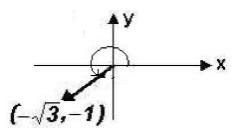INTRODUCTION TO VECTORS - PART 1
Example 1:
Let w be a vector in a rectangular coordinate system with initial point P at (1, – 3) and terminal point Q at (– 5, 3). Write the vector v in component form.
Basically, we are asked to place the vector into standard position. We will use the formula < x2 – x1 , y2 – y1 > ("terminal minus initial") which is the component form of a vector that has been moved from somewhere in the coordinate system to standard position. While developing the formula, we assigned the coordinates (x1, y1) to the initial point P and (x2, y2) to the terminal point Q.
Therefore, the component form of vector w must be < – 5 – 1, 3 – (– 3) >. Simplifying, we find the component form of vector w to be < – 6, 6 >.
Example 2:
Calculate the EXACT magnitude of v = < 3, 2 >.
Given ||v|| =
, we find ||v|| =
Example 3:
Calculate the EXACT magnitude of v = < 0,
7 >.
Given ||v|| =
, we find ||v|| =
Example 4:
Calculate the EXACT magnitude of v = <
4,
3 >.
Given ||v|| =
, we find ||v|| =
Example 5:
Calculate the EXACT magnitude of v = < 8, 0 >.
Given ||v|| =
, we find ||v|| =
Example 6:
Find the direction angle of vector
.
Let's look at a picture of the vector and its direction angle. Remember that a direction angle is positive and measured from the positive x-axis to the vector in standard position as shown below!
From earlier work we know that
, therefore, we find
and
Looking at the graph of the vector, we know that we are required to find a positive angle whose terminal side is in Quadrant IV.
We will use the Reference Angle of
60o which is 60o to find that the direction angle must equal 300o.
Example 7:
Find the direction angle of vector
.
Let's look at a picture of the vector and its direction angle.Remember that a direction angle is positive and measured from the positive x-axis to the vector in standard position as shown below!
Knowing that
, we can find
and
Looking at the graph of the vector, we know that we are required to find a positive angle whose terminal side is in Quadrant IV. We will use the Reference Angle of 30o which is 30o to find that the direction angle must equal 210o.
Example 8:
Let v = <
2, 5 > and w = < 3, 4 >. Find the following:
(a) v + w = <
2, 5 > + < 3, 4 >
= <
2 + 3, 5 + 4>
= < 1, 9>
(b) 2v
2v = 2<
2, 5 >
= <
4, 10 >
(c) w
v
w
v = < 3, 4 >
<
2, 5 >
= < 3
(
2), 4
5 >
= < 5,
1 >
(d) v + 2w
v + 2w = <
2, 5 > + 2< 3, 4 >
= < 4, 13 >


